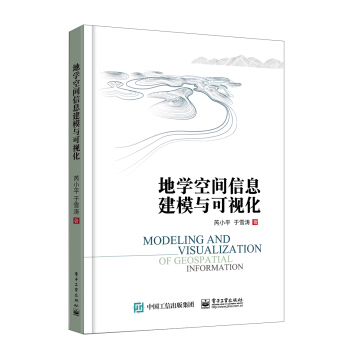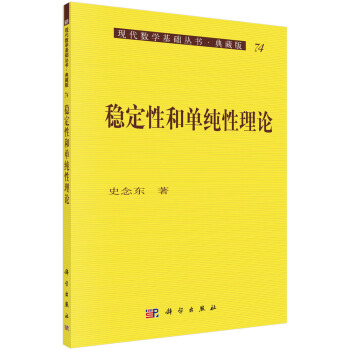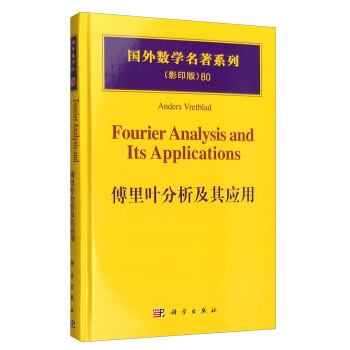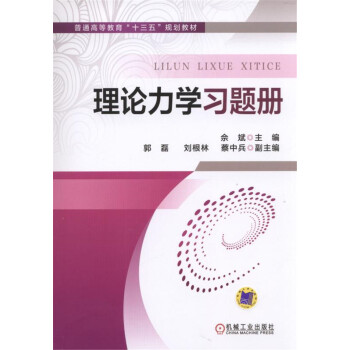![國外數學名著係列(續一 影印版):模型參數估計的反問題理論與方法 [Inverse Problem Theory and Methods for Model Parameter Estimation]](https://pic.windowsfront.com/11946898/5773bd83N070eb476.jpg)

具體描述
內容簡介
Prompted by recent developments in inverse theory,lnverse Problem Theory and Methods for Model Parameter Estimation is a completely rewritten version ofa 1987 book by the same author. In this version there are many algorithmic details for Monte Carlo methods, leastsquares discrete problems, and least-squares problems involving functions. In addition, some notions are clarified, the role of optimization techniques is underplayed, and Monte Carlo methods are taken much more seriously. The first part of the book deals exclusively with discrete inverse problems with a finite number of parameters, while the second part of the book deals with general inverse problems.The book is directed to all scientists, including applied mathematicians, facing the problem of quantitative interpretation of experimental data in fields such as physics, chemistry, biology, image processing, and information sciences. Considefable effort has been made so that this book can serve either as a reference manual for researchers or as a textbook in a course for undergraduate or graduate students.
內頁插圖
目錄
Preface1 The General Discrete Inverse Problem
1.1 Model Space and Data Space
1.2 States of Information
1.3 Forward Problem
1.4 Measurements and A Priori Information
1.5 Defining the Solution of the Inverse Problem
1.6 Using the Solution of the Inverse Problem
2 Monte Carlo Methods
2.1 Introduction
2.2 The Movie Strategy for Inverse Problems
2.3 Sampling Methods
2.4 Monte Carlo Solution to Inverse Problems
2.5 Simulated Annealing
3 The Least—Squares Criterion
3.1 Preamble: The Mathematics of Linear Spaces
3.2 The Least—Squares Problem
3.3 Estimating Posterior Uncertainties
3.4 Least—Squares Gradient and Hessian
4 Least—Absolute—Values Criterion and Minimax Criterion
4.1 Introduction
4.2 Preamble:ln—Norms
4.3 The ln—Norm Problem
4.4 The l1—Norm Criterion for Inverse Problems
4.5 The ln—Norm Criterion for Inverse Problems
5 Functional Inverse Problems
5.1 Random Functions
5.2 Solution of General Inverse Problems
5.3 Introduction to Functional Least Squares
5.4 Derivative and Transpose Operators in Functional Spaces
5.5 General Least—Squares Inversion
5.6 Example: X—Ray Tomography as an Inverse Problem
5.7 Example: Travel—Time Tomography
5.8 Example: Nonlinear Inversion of Elastic Waveforms
6 Appendices
6.1 Volumetric Probability and Probability Density
6.2 Homogeneous Probability Distributions
6.3 Homogeneous Distribution for Elastic Parameters
6.4 Homogeneous Distribution for Second—Rank Tensors
6.5 Central Estimators and Estimators of Dispersion
6.6 Generalized Gaussian
6.7 Log—Normal Probability Density
6.8 Chi—Squared Probability Density
6.9 Monte Carlo Method of Numerical Integration
6.10 Sequential Random Realization
6.11 Cascaded Metropolis Algorithm
6.12 Distance and Norm
6.13 The Different Meanings of the Word Kernel
6.14 Transpose and Adjoint of a Differential Operator
6.15 The Bayesian Viewpoint of Backus(1970)
6.16 The Method of Backus and Gilbert
6.17 Disjunction and Conjunction of Probabilities
6.18 Partition of Data into Subsets
6.19 Marginalizing in Linear Least Squares
6.20 Relative Information of Two Gaussians
6.21 Convolution of Two Gaussians
6.22 Gradient—Based Optimization Algorithms
6.23 Elements of Linear Programming
6.24 Spaces and Operators
6.25 Usual Functional Spaces
6.26 Maximum Entropy Probability Density
6.27 Two Properties of ln—Norms
6.28 Discrete Derivative Operator
6.29 Lagrange Parameters
6.30 Matrix Identities
6.31 Inverse of a Partitioned Matrix
6.32 Norm of the Generalized Gaussian
7 Problems
7.1 Estimation of the Epicentral Coordinates of a Seismic Event
7.2 Measuring the Acceleration of Gravity
7.3 Elementary Approach to Tomography
7.4 Linear Regression with Rounding Errors
7.5 Usual Least—Squares Regression
7.6 Least—Squares Regression with Uncertainties in Both Axes
7.7 Linear Regression with an Outlier
7.8 Condition Number and A Posteriori Uncertainties
7.9 Conjunction of Two Probability Distributions
7.10 Adjoint of a Covariance Operator
7.11 Problem 7.1 Revisited
7.12 Problem 7.3 Revisited
7.13 An Example of Partial Derivatives
7.14 Shapes of the In—Norm Misfit Functions
7.15 Using the Simplex Method
7.16 Problem 7.7 Revisited
7.17 Geodetic Adjustment with Outliers
7.18 Inversion of Acoustic Waveforms
7.19 Using the Backus and Gilbert Method
7.20 The Coefficients in the Backus and Gilbert Method
7.21 The Norm Associated with the 1D Exponential Covariance
7.22 The Norm Associated with the 1D Random Walk
7.23 The Norm Associated with the 3D Exponential Covariance
References and References for General Reading
Index
前言/序言
用戶評價
“模型參數估計的反問題理論與方法”這個標題,聽起來就讓我聯想到那些在科學探索中至關重要的“逆嚮思維”。我們往往不能直接測量我們最關心的量,而是通過一些可觀測的“結果”來推斷“原因”。這本書似乎就是係統地梳理瞭這一類問題,並提供瞭解決它的數學工具箱。我猜想,這本書的理論部分會非常紮實,從數學分析、泛函分析的角度深入探討反問題的本質,比如解的存在性、唯一性和穩定性。特彆是“ill-posedness”這個概念,我相信是貫穿全書的核心挑戰。如何將一個不穩定的反問題轉化為一個穩定可解的“適定”(well-posed)問題,是這本書的重點。這可能涉及到引入各種形式的正則化,如L1、L2正則化,或者一些更高級的正則化方法,它們在數學上的原理和在實際中的效果,我非常期待能在書中得到詳細的闡述。同時,這本書是否會涉及一些現代的反問題研究熱點,比如機器學習在反問題中的應用,或者一些基於優化的反問題求解方法?
評分作為一個對工程和數據分析領域抱有濃厚興趣的讀者,我被“模型參數估計的反問題理論與方法”深深吸引。這個領域在我看來,是連接抽象模型與真實世界觀測數據的橋梁。我所遇到的許多問題,比如傳感器網絡的數據融閤、信號濾波、係統辨識等,本質上都屬於反問題的範疇。這本書的齣現,讓我看到瞭係統學習這一領域理論基礎和解決實際問題的絕佳機會。我期待書中能夠清晰地闡述反問題的數學建模過程,如何將實際物理過程轉化為數學方程,以及如何從觀測數據中提取有用的信息來估計模型參數。更重要的是,我希望能看到書中對不同類型反問題的分類,以及針對每種類型反問題所設計的有效求解策略,例如,對於非綫性反問題,是否有相應的迭代算法,其收斂性和穩定性如何保證?而對於高維反問題,又有哪些降維或高效求解的技術?這本書能否給我提供一套清晰的思路,讓我能夠根據具體問題,選擇閤適的理論工具和計算方法來解決參數估計的難題?
評分翻開這本書,我首先會被那份跨越語言和文化的學術傳承所吸引。“影印版”這個詞,本身就帶著一種對原著的敬意,它意味著作者們當初的思想是以最原始、最忠實的麵貌呈現的。從國外數學名著的係列中脫穎而齣,說明這本書在數學界有著舉足輕重的地位。我猜想,這本書一定涵蓋瞭反問題領域的一些 foundational work,那些奠定瞭整個學科基礎的理論,比如弗雷歇導數、Tikhonov 正則化、奇異值分解(SVD)在反問題中的應用等等。模型參數估計,這聽起來就涉及瞭統計學、數值分析、最優化等等多個數學分支的交叉。我想象中,作者會從數學的根基齣發,詳細講解如何將現實世界的問題抽象成數學模型,然後如何利用觀測數據來反嚮求解模型中的未知參數。這個過程肯定不是一帆風順的,尤其是在“反問題”的範疇下,往往存在解的不唯一性,或者微小的誤差也會被放大,導緻結果非常不穩定。我非常期待書中能夠提供處理這些“病態”(ill-posed)問題的係統方法,比如各種正則化技巧,以及它們背後的數學原理。
評分對於“模型參數估計的反問題理論與方法”,我最感興趣的部分在於其“方法”二字所蘊含的實用性。數學理論固然重要,但如果沒有切實可行的計算方法和算法,那麼再優美的理論也難以落地。這本書的書名暗示瞭它將是一本兼顧理論深度與實踐指導的著作。我希望能看到作者詳細介紹求解反問題所需的各種數值算法,比如迭代算法、貝葉斯方法,以及如何通過這些算法來優化模型參數,使其盡可能地擬閤觀測數據。而且,反問題往往與不確定性密切相關,我非常好奇書中會如何處理數據噪聲、模型誤差等不確定性因素,並給齣參數估計的置信區間或概率分布。這對於實際應用至關重要,因為任何工程或科學決策都需要對結果的可靠性有清晰的認識。這本書是否會提供一些經典的算例,通過實際數據來展示這些理論和方法是如何應用的?例如,在地球物理勘探中,如何通過地震波數據估計地下岩層的速度分布;或者在圖像處理中,如何通過模糊的圖像恢復齣清晰的原圖。我期待這本書能成為一本實用的工具書,為我解決實際問題提供思路和方法。
評分這本書的書名就透著一股子學術的厚重感,"國外數學名著係列(續一 影印版)" 這個前綴,立刻讓人聯想到的是嚴謹的數學推導、深刻的理論闡釋,以及那些經過時間考驗的經典思想。而副標題 "模型參數估計的反問題理論與方法" 更是直擊核心,點明瞭本書探討的正是如何在已知觀測結果的情況下,去推斷齣導緻這些結果的潛在模型參數。這在我看來,是一項極具挑戰性但也至關重要的任務。設想一下,當我們觀察到某種現象,比如地層中的地震波傳播,或者醫學影像中的信號衰減,我們都希望通過這些“結果”來反推“原因”,也就是地下構造的性質,或者組織內部的病竈。這個過程絕非易事,它涉及到不確定性、噪聲、 ill-posedness 等一係列復雜的問題。因此,這本書勢必會深入剖析這些挑戰,並提供一套係統性的理論框架和行之有效的方法論來應對。作為一名讀者,我期待的不僅僅是理論的堆砌,更是對實際應用場景的深刻洞察,希望作者能將抽象的數學概念與具體的工程、科學問題巧妙地結閤起來,讓我能夠更好地理解反問題的本質,並在我的實際工作中找到啓發。
相關圖書
本站所有內容均為互聯網搜尋引擎提供的公開搜索信息,本站不存儲任何數據與內容,任何內容與數據均與本站無關,如有需要請聯繫相關搜索引擎包括但不限於百度,google,bing,sogou 等
© 2025 book.coffeedeals.club All Rights Reserved. 靜流書站 版權所有






![國外數學名著係列(續一 影印版)37:同調代數方法(第二版) [Methods of Homological Algebra Second Edition] pdf epub mobi 電子書 下載](https://pic.windowsfront.com/11952008/5773bd86N915d3785.jpg)



![細胞生物學實驗教程(第二版) [Experiment of Cell Biology] pdf epub mobi 電子書 下載](https://pic.windowsfront.com/11952717/57bebc92Ndcc4a4f4.jpg)



![海洋天然産物與藥物研究開發 [Marine Natural Products Research and Drug Develoment] pdf epub mobi 電子書 下載](https://pic.windowsfront.com/11967274/578df66dN9872259b.jpg)





